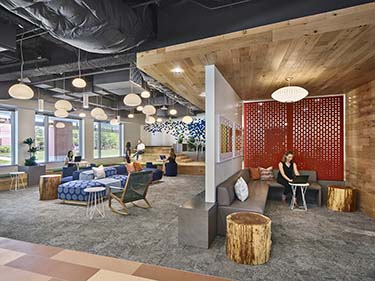|
Subscribe / Renew |
|
|
Contact Us |
|
| ► Subscribe to our Free Weekly Newsletter | |
| home | Welcome, sign in or click here to subscribe. | login |
Architecture & Engineering
| |
 |
March 4, 2021
A changed workforce and the implications for workplaces and cities
Gensler Seattle

Haines
|
The all-but-complete inability to work in the office to stem the transmission of COVID-19 has been the most significant driver of change in workforce expectations in decades. Initially led by large technology companies, long the guide for the future workplaces, becoming a home-based workforce required quick action to maintain business continuity.
Significant investment in scaling cloud infrastructure, providing accommodations for employees’ productivity, attention to sustaining team effectiveness and employee engagement have all been accelerated by necessity.
Impacting teams, managers, and executives alike, this shift has been more comprehensive than past disruptions to workplace norms. COVID-19 inspired the change that proved many long-held beliefs about more flexible work cultures to be false. We learned we can work effectively in some of our responsibilities from remote locations — transcending the stereotypes about trust, productivity, value and commitment to a company.
We discovered we could be productive and have time for ourselves, our families, and other activities that give us joy — a work/life balance that had increasingly seemed unachievable. Top of mind is which of our newfound abilities will stick versus revert and the implications on our workplaces and the cities in which they are based.
WORKFORCE PREFERENCE
While we have learned to come together virtually, our research clearly shows we’re missing the day-to-day interactions, in-person collaboration, and face-to-face conversations that the office provides. Gensler’s Research Institute’s 2020 Workplace Survey shows only 19% want to work from home full-time, representing a minority many businesses will be better able to accommodate now. Conversely, only 29% prefer to be in the office full-time.
Therefore, more than half of respondents desire a hybrid work model in the future, coming to the office one to four days of a given week. The influence of commute durations is significant with each 15 minutes contributing to approximately 15% reduction in preference for full-time work in the office. Importantly for employers, surveys of teams already working in a hybrid model suggest improvements in many key indicators.
As we transition to a post-vaccine environment, what will attract employees to come to the office? The experience must be worth it.
EXPERIENTIAL WORKPLACE
Many have foretold of a dramatic reduction in workspace demand; however, a closer look suggests the workplace still matters for building community, supporting collaboration, and reinforcing culture. As such, the office designed for the hybrid model is less about shedding space but rather using it better. Resilience in new workplaces will emerge due to a reduction in assigned desks with more places for collaboration and team productivity, removing the linear relationship between population and square footage. Fewer future requests for more space may be the longer-term effect for landlords.
In designing the new hybrid workplace, “we” spaces must truly focus on the inclusion of a broader population. Remote attendees will demand parity for in-person and remote attendees. This will require a focus on analog and digital components and attendee soft skills. With video pervasive, an even greater focus on the experience for attendees will drive A/V integration to the core of room designs.
Desks may be fewer, providing spaces for individuals or small teams to focus. While we have learned that home can provide a controllable environment for focused work, not all have ideal conditions. Focused activity spaces, which had seen diminishing satisfaction in 2019 surveys, will be needed during visits to the office for more collaborative sessions.
Social spaces are also going to make a resurgence, enabling the creation of culture, team bond-building, extending to hosting community organizations who can benefit from great spaces that support shared missions and discourse. In what we at Gensler refer to as a workplace with heart — leading with empathy and supporting people’s ability to be creative, successful and connected wherever they are.
THE CITY CORE
Many ask, if fewer people will come downtown each day, will there be a resurgence in the service industry, and will street fronts be revitalized? I choose to take an optimistic view for the future — one of intention. The adoption of the hybrid workplace and leveraged space could drive higher downtown daily populations each day, though perhaps for less hours per person. The same craving to connect in the workplace will also support coffee shops, restaurants, and retail zones.
The difference I believe is the level of expectation for a great experience will be dramatically higher seeking to make time in the city “count.” Many of us have gone out of our way to support favorite small businesses, due in large part to past great experiences. Downtown will be no different and those that deliver on it will be rewarded.
Those who deliver diverse experiences throughout the day will likely fare better, extending their operating hours per square foot. There’s no arguing vacancy is a near term reality and it will take time and support, but I believe the central business district could see more activity by reimagining the ground floor of our cities — to celebrate culture and diversity through multi-use spaces and enabling buildings to become a more integral part of the community at large.
We must hold onto what we’ve learned and embrace this new ecosystem of a work/life balance. And as we continue to navigate how exactly our new work model will look, one thing is certain; we need to stop focusing on getting “back to work” versus “advancing” our workplaces to exceed these new expectations.
Ryan Haines is an architect, principal, the co-managing director of Gensler’s Seattle office, and leader of the consulting practice in the Northwest region.
Other Stories:
- How to keep the creative spark in a virtual world
- The role of ventilation and healthy air
- It’s the end of the grocery store (as we know it)
- Are American shopping malls boxed-in?
- Influencing human scale, creating a sense of place
- Here are the 3 principles of renovation
- The future of resilient commercial real estate
- Not all feasibility studies are created equal
- Green Lake Community Center aims for inclusivity
- What if you can’t dig your way out of a brownfield cleanup?
- How A/E firms can increase proposal success in 2021
- 4 Living Buildings: collaborative, courageous, open-minded learning
- Workplace wellness through technology
- Foundations for healthy and sustainable urban places
- Parking garages: rethinking your front door



